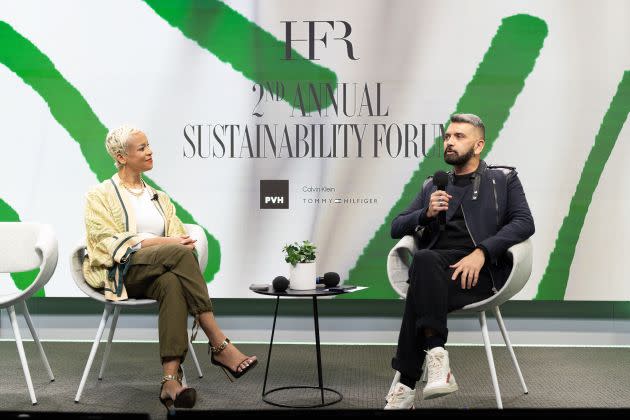Harlem’s Fashion Row Returns With Second Annual Sustainability Conference With H&M, Google

NEW YORK — Harlem’s Fashion Row presented its second annual sustainability summit Wednesday, in partnership with H&M and hosted at Google.
“If you want to think about the brands you should support, you should support the brands that support us [at Harlem Fashion Row],” said Brandice Daniel, in between session breaks to the room of attendees spanning designers, brands, students and more.
More from WWD
The event put a spotlight on the importance of environmental stewardship and diversity in the sustainable fashion world. Speakers spanned Bridgett Artise, author and designer of “Born-Again Vintage”; Abi Kammerzell, head of sustainability at H&M North America; Simone Harris-Laws, senior director of diversity, equity and inclusion at Macy’s; Rohit Burman, vice president of sustainability and DEI at Calvin Klein Global and PVH, and TayLa Littles, sustainability and business partner at Google, among others.
Burman spoke to the “level of scrutiny” that has accelerated among PVH investors and board members, with legislation being a big push that brands are watching closely. Under Burman’s helm, Calvin Klein saved 650,000 pounds of plastic in one year by removing plastic from Calvin Klein’s men’s underwear packaging in North American markets alone. “We can often be our own worst enemy. We become very technical very quickly…but sometimes it’s making [sustainability] simple,” he summarized. “Intentional pauses,” in his words, are what helps his team navigate sustainability and inclusivity in today’s landscape. “That’s also how we build an inclusive workplace,” he reiterated.
Afterward, Littles relayed how the tech company is closing the “say do” sustainable action gap between businesses and consumers. The “say do” action gap is one in which both companies and consumers say they want sustainability but gaps exist between acting on intentions, be it individual behavioral changes or broader systems needs. Google data showed 85 percent of consumers have become “greener” in recent years and terms like “textile recycling” and “thrifting” have hit record highs.
Certain user experience designs aid further eco-intentions from shoppers. One Google fashion case study (which was undisclosed) found a 110 percent increase in shop engagement by adding a “find my size” feature. For one, shoppers are twice as likely to purchase from a website in dark mode (a green UX feature that saves energy).
It all comes back to intention. “Be purposeful, be intentional and know why you’re doing what you’re doing,” said Kris Harrington, 3D tech lead at Browzwear, and founder of label Kris Harring, in another session on tech’s advantage.
Before Daniel returned to the stage to close the day’s programming, she and Hope for Flowers designer Tracy Reese sat down for a fireside chat. Reese’s advice for the crowd was: there’s no job that is too small, but know when to walk away.
For sustainability progress, she asserted: “Our industry will not move forward if it’s not collaborative.”
Best of WWD

